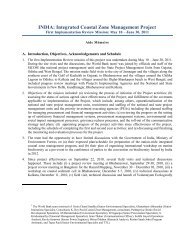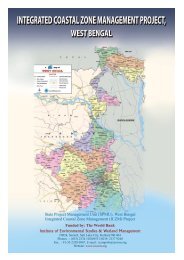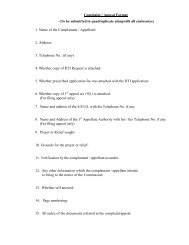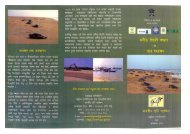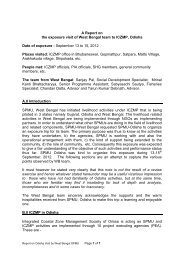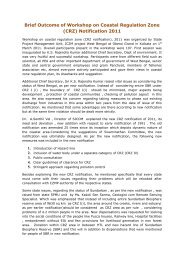Cyclone and Storm Surge - Iczmpwb.org
Cyclone and Storm Surge - Iczmpwb.org
Cyclone and Storm Surge - Iczmpwb.org
You also want an ePaper? Increase the reach of your titles
YUMPU automatically turns print PDFs into web optimized ePapers that Google loves.
3.9<br />
ebb out as that flowed in, it follows that the average velocity of ebb is less than that of flow. Now the<br />
sediment carrying capacity of flow is a direct function of velocity. Hence it follows that the ebb tide is<br />
generally unable to carry back fully the sediment which has been carried up the tidal river during flow<br />
tide. Consequently sediment will get deposited on the channel bed. Even a slight deposition of<br />
sediment will go on accumulating, since the tides occur twice a day, throughout the year without a<br />
break. As a result, the channel bed will begin to rise <strong>and</strong> its carrying capacity will deteriorate. The<br />
deterioration will impede the propagation of tidal wave which would cause further deterioration <strong>and</strong><br />
the vicious circle would continue till the channel is completely dead.<br />
To maintain the life of a tidal channel it is necessary to provide additional supply of water not<br />
saturated with sediment, which has reserve capacity to pick up more sediment, to supplement the<br />
tidal flow during the ebb so as to scour out fully that has entered the channel during the flow tide.<br />
This can be done by (1) supply of upl<strong>and</strong> water, (2) local drainage or (3) throwing open additional<br />
spill areas. After the shifting of the main flow of the Ganga from the Bhagirathi to the Padma, upl<strong>and</strong><br />
supply of sediment free flow got severely reduced to the Bhagirathi <strong>and</strong> the other distributaries of the<br />
vicinity. The reduction was so severe that before Farakka Barrage diverted some flow into it, the<br />
Bhagirathy remained completely cut off from the Ganga for full nine months in a year. The second<br />
option is there; but local drainage is small in volume <strong>and</strong> seasonal in nature <strong>and</strong> so of very little<br />
consequence. And it is very difficult to implement the third option. Anthropogenic interventions like<br />
erection of marginal embankments for premature l<strong>and</strong> reclamation <strong>and</strong> erection of fisheries <strong>and</strong> brick<br />
fields have actually drastically reduced natural spill areas. Hence, it is extremely important to monitor<br />
the condition of these tidal channels in <strong>and</strong> around Kolkata <strong>and</strong> to ensure their sustenance.<br />
3.8. Deteriorating state of health of river Bidyadhari<br />
The recommendations (1924) of the Calcutta Improvement Trust were made with the supposition that<br />
the Bidyadhari river was capable of carrying off the entire volume of sewage <strong>and</strong> drainage effluent<br />
from the city. But unfortunatery; the river by this time had already shown signs of distrees. When the<br />
Central Lake Channel of the Bidyadhari river was selected as the city's outfall, the river was in fine<br />
shape. It was 1500ft. wide <strong>and</strong> 60ft. deep at low water. Bidhyadhari used to get a considerable<br />
supply of upl<strong>and</strong> water including a portion of the dry weather flow of the Ganga (Bhagirathy channel),<br />
which carried the major part of the flow of theGanga till the end of the 15th Century or early in the<br />
16th Century. It also received the upl<strong>and</strong> flow of the local channels like the Sunti, Nowi <strong>and</strong> Nona<br />
Gang. Even when the main flow of the Ganga was diverted, it seems probable that it still continued to









